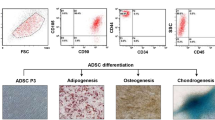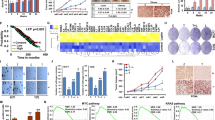Abstract
Growing evidence indicates that resistin—an obesity-related cytokine—is upregulated in breast cancer patients, yet its impact on breast cancer behavior remains to be ascertained. Similarly, Toll-like receptor 4 (TLR4) has been implicated in breast cancer progression, however, its clinically relevant endogenous ligand remains elusive. In this study, we observed that high serum resistin levels in breast cancer patients positively correlated with tumor stage, size and lymph node metastasis. These findings were replicated in animal models of breast cancer tumorigenesis and metastasis. Resistin was found to promote epithelial–mesenchymal transition and stemness in breast cancer cells—mechanisms critical to tumorigenesis and metastasis—through a TLR4/nuclear factor kappa-light-chain-enhancer of activated B cells (NF-κB)/signal transducer and activator of transcription 3 (STAT3) signaling pathway and negated by TLR4-specific antibody and antagonist. These findings provide clear evidence that resistin is a clinically relevant endogenous ligand for TLR4, which promotes tumor progression via TLR4/NF-κB/STAT3 signaling, providing insights into a novel therapeutic target in breast cancer.
This is a preview of subscription content, access via your institution
Access options
Subscribe to this journal
Receive 50 print issues and online access
$259.00 per year
only $5.18 per issue
Buy this article
- Purchase on Springer Link
- Instant access to full article PDF
Prices may be subject to local taxes which are calculated during checkout





Similar content being viewed by others
References
Conde J, Scotece M, Gomez R, Lopez V, Gomez-Reino JJ, Lago F et al. Adipokines: biofactors from white adipose tissue. A complex hub among inflammation, metabolism, and immunity. Biofactors 2011; 37: 413–420.
Steppan CM, Bailey ST, Bhat S, Brown EJ, Banerjee RR, Wright CM et al. The hormone resistin links obesity to diabetes. Nature 2001; 409: 307–312.
Patel L, Buckels AC, Kinghorn IJ, Murdock PR, Holbrook JD, Plumpton C et al. Resistin is expressed in human macrophages and directly regulated by PPAR gamma activators. Biochem Biophys Res Commun 2003; 300: 472–476.
McTernan CL, McTernan PG, Harte AL, Levick PL, Barnett AH, Kumar S . Resistin, central obesity, and type 2 diabetes. Lancet 2002; 359: 46–47.
Schwartz DR, Lazar MA . Human resistin: found in translation from mouse to man. Trends Endocrinol Metab 2011; 22: 259–265.
Codoner-Franch P, Alonso-Iglesias E . Resistin: insulin resistance to malignancy. Clin Chim Acta 2015; 438: 46–54.
Lopez-Novoa JM, Nieto MA . Inflammation and EMT: an alliance towards organ fibrosis and cancer progression. EMBO Mol Med 2009; 1: 303–314.
Peinado H, Olmeda D, Cano A . Snail, Zeb and bHLH factors in tumour progression: an alliance against the epithelial phenotype? Nat Rev Cancer 2007; 7: 415–428.
Iwatsuki M, Mimori K, Yokobori T, Ishi H, Beppu T, Nakamori S et al. Epithelial-mesenchymal transition in cancer development and its clinical significance. Cancer Sci 2010; 101: 293–299.
Gonzalez DM, Medici D . Signaling mechanisms of the epithelial-mesenchymal transition. Sci Signal 2014; 7: re8.
May CD, Sphyris N, Evans KW, Werden SJ, Guo W, Mani SA . Epithelial-mesenchymal transition and cancer stem cells: a dangerously dynamic duo in breast cancer progression. Breast Cancer Res 2011; 13: 202.
Mani SA, Guo W, Liao MJ, Eaton EN, Ayyanan A, Zhou AY et al. The epithelial-mesenchymal transition generates cells with properties of stem cells. Cell 2008; 133: 704–715.
Li L, Cole J, Margolin DA . Cancer stem cell and stromal microenvironment. Ochsner J 2013; 13: 109–118.
Al-Hajj M, Wicha MS, Benito-Hernandez A, Morrison SJ, Clarke MF . Prospective identification of tumorigenic breast cancer cells. Proc Natl Acad Sci USA 2003; 100: 3983–3988.
Iqbal J, Chong PY, Tan PH . Breast cancer stem cells: an update. J Clin Pathol 2013; 66: 485–490.
Lee YC, Chen YJ, Wu CC, Lo S, Hou MF, Yuan SS . Resistin expression in breast cancer tissue as a marker of prognosis and hormone therapy stratification. Gynecol Oncol 2012; 125: 742–750.
Assiri AM, Kamel HF, Hassanien MF . Resistin, visfatin, adiponectin, and leptin: risk of breast cancer in pre- and postmenopausal Saudi females and their possible diagnostic and predictive implications as novel biomarkers. Dis Markers 2015; 2015: 253519.
Drasin DJ, Robin TP, Ford HL . Breast cancer epithelial-to-mesenchymal transition: examining the functional consequences of plasticity. Breast Cancer Res 2011; 13: 226.
Grimshaw MJ, Cooper L, Papazisis K, Coleman JA, Bohnenkamp HR, Chiapero-Stanke L et al. Mammosphere culture of metastatic breast cancer cells enriches for tumorigenic breast cancer cells. Breast Cancer Res 2008; 10: R52.
Ponti D, Costa A, Zaffaroni N, Pratesi G, Petrangolini G, Coradini D et al. Isolation and in vitro propagation of tumorigenic breast cancer cells with stem/progenitor cell properties. Cancer Res 2005; 65: 5506–5511.
Hu Y, Smyth GK . ELDA: extreme limiting dilution analysis for comparing depleted and enriched populations in stem cell and other assays. J Immunol Methods 2009; 347: 70–78.
Chung SS, Vadgama JV . Curcumin and epigallocatechin gallate inhibit the cancer stem cell phenotype via down-regulation of STAT3-NFkappaB signaling. Anticancer Res 2015; 35: 39–46.
Zhang X, Zhao X, Shao S, Zuo X, Ning Q, Luo M et al. Notch1 induces epithelial-mesenchymal transition and the cancer stem cell phenotype in breast cancer cells and STAT3 plays a key role. Int J Oncol 2015; 46: 1141–1148.
Wang W, Nag SA, Zhang R . Targeting the NFkappaB signaling pathways for breast cancer prevention and therapy. Curr Med Chem 2015; 22: 264–289.
Gonzalez-Reyes S, Marin L, Gonzalez L, Gonzalez LO, del Casar JM, Lamelas ML et al. Study of TLR3, TLR4 and TLR9 in breast carcinomas and their association with metastasis. BMC Cancer 2010; 10: 665.
Ehsan N, Murad S, Ashiq T, Mansoor MU, Gul S, Khalid S et al. Significant correlation of TLR4 expression with the clinicopathological features of invasive ductal carcinoma of the breast. Tumour Biol 2013; 34: 1053–1059.
Tarkowski A, Bjersing J, Shestakov A, Bokarewa MI . Resistin competes with lipopolysaccharide for binding to toll-like receptor 4. J Cell Mol Med 2010; 14: 1419–1431.
Kawai T, Akira S . TLR signaling. Cell Death Differ 2006; 13: 816–825.
Heinrich PC, Behrmann I, Haan S, Hermanns HM, Muller-Newen G, Schaper F . Principles of interleukin (IL)-6-type cytokine signalling and its regulation. Biochem J 2003; 374: 1–20.
Syed V, Ulinski G, Mok SC, Ho SM . Reproductive hormone-induced, STAT3-mediated interleukin 6 action in normal and malignant human ovarian surface epithelial cells. J Natl Cancer Inst 2002; 94: 617–629.
Teng Y, Xie X, Walker S, White DT, Mumm JS, Cowell JK . Evaluating human cancer cell metastasis in zebrafish. BMC Cancer 2013; 13: 453.
Hwang-Verslues WW, Kuo WH, Chang PH, Pan CC, Wang HH, Tsai ST et al. Multiple lineages of human breast cancer stem/progenitor cells identified by profiling with stem cell markers. PLoS One 2009; 4: e8377.
Zhou C, Liu J, Tang Y, Liang X . Inflammation linking EMT and cancer stem cells. Oral Oncol 2012; 48: 1068–1075.
Wendt MK, Balanis N, Carlin CR, Schiemann WP . STAT3 and epithelial-mesenchymal transitions in carcinomas. JAKSTAT 2014; 3: e28975.
Yu H, Lee H, Herrmann A, Buettner R, Jove R . Revisiting STAT3 signalling in cancer: new and unexpected biological functions. Nat Rev Cancer 2014; 14: 736–746.
Shostak K, Chariot A . NF-kappaB, stem cells and breast cancer: the links get stronger. Breast Cancer Res 2011; 13: 214.
Lee JO, Kim N, Lee HJ, Lee YW, Kim SJ, Park SH et al. Resistin, a fat-derived secretory factor, promotes metastasis of MDA-MB-231 human breast cancer cells through ERM activation. Sci Rep 2016; 6: 18923.
Mehmeti M, Allaoui R, Bergenfelz C, Saal LH, Ethier SP, Johansson ME et al. Expression of functional toll like receptor 4 in estrogen receptor/progesterone receptor-negative breast cancer. Breast Cancer Res 2015; 17: 130.
Chen YH, Lee MJ, Chang HH, Hung PF, Kao YH . 17 Beta-estradiol stimulates resistin gene expression in 3T3-L1 adipocytes via the estrogen receptor, extracellularly regulated kinase, and CCAAT/enhancer binding protein-alpha pathways. Endocrinology 2006; 147: 4496–4504.
Lee MJ, Lin H, Liu CW, Wu MH, Liao WJ, Chang HH et al. Octylphenol stimulates resistin gene expression in 3T3-L1 adipocytes via the estrogen receptor and extracellular signal-regulated kinase pathways. Am J Physiol Cell Physiol 2008; 294: C1542–C1551.
Franco HL, Nagari A, Kraus WL . TNFalpha signaling exposes latent estrogen receptor binding sites to alter the breast cancer cell transcriptome. Mol Cell 2015; 58: 21–34.
Frasor J, Weaver A, Pradhan M, Dai Y, Miller LD, Lin CY et al. Positive cross-talk between estrogen receptor and NF-kappaB in breast cancer. Cancer Res 2009; 69: 8918–8925.
Pradhan M, Bembinster LA, Baumgarten SC, Frasor J . Proinflammatory cytokines enhance estrogen-dependent expression of the multidrug transporter gene ABCG2 through estrogen receptor and NF{kappa}B cooperativity at adjacent response elements. J Biol Chem 2010; 285: 31100–31106.
Oblak A, Jerala R . Toll-like receptor 4 activation in cancer progression and therapy. Clin Dev Immunol 2011; 2011: 609579.
Bauer AK, Dixon D, DeGraff LM, Cho HY, Walker CR, Malkinson AM et al. Toll-like receptor 4 in butylated hydroxytoluene-induced mouse pulmonary inflammation and tumorigenesis. J Natl Cancer Inst 2005; 97: 1778–1781.
Jing YY, Han ZP, Sun K, Zhang SS, Hou J, Liu Y et al. Toll-like receptor 4 signaling promotes epithelial-mesenchymal transition in human hepatocellular carcinoma induced by lipopolysaccharide. BMC Med 2012; 10: 98.
Yang H, Wang B, Wang T, Xu L, He C, Wen H et al. Toll-like receptor 4 prompts human breast cancer cells invasiveness via lipopolysaccharide stimulation and is overexpressed in patients with lymph node metastasis. PLoS One 2014; 9: e109980.
Song J, Duncan MJ, Li G, Chan C, Grady R, Stapleton A et al. A novel TLR4-mediated signaling pathway leading to IL-6 responses in human bladder epithelial cells. PLoS Pathog 2007; 3: e60.
Yokota S, Okabayashi T, Rehli M, Fujii N, Amano K . Helicobacter pylori lipopolysaccharides upregulate toll-like receptor 4 expression and proliferation of gastric epithelial cells via the MEK1/2-ERK1/2 mitogen-activated protein kinase pathway. Infect Immun 2010; 78: 468–476.
Hsieh YY, Shen CH, Huang WS, Chin CC, Kuo YH, Hsieh MC et al. Resistin-induced stromal cell-derived factor-1 expression through Toll-like receptor 4 and activation of p38 MAPK/ NFkappaB signaling pathway in gastric cancer cells. J Biomed Sci 2014; 21: 59.
Acknowledgements
We thank Dr Tsung-Hsien Chuang and Dr Wen-Chun Hung from National Health Research Institutes, Taiwan, for providing plasmid. This work was supported by Kaohsiung Medical University Hospital (KMUH102-2T07, KMUH103-3R28, KMUH104-4R29); Kaohsiung Medical University (Aim for the Top Journals Grant, KMU-DT105008, KMU-TP104D17); National Health Research Institutes (NHRI-EX104-10212BI); and Ministry of Health and Welfare, Health and welfare surcharge of tobacco products (MOHW105-TDU-B-212-134007) of Taiwan.
Author information
Authors and Affiliations
Corresponding author
Ethics declarations
Competing interests
The authors declare no conflict of interest.
Additional information
Supplementary Information accompanies this paper on the Oncogene website
Supplementary information
Rights and permissions
About this article
Cite this article
Wang, CH., Wang, PJ., Hsieh, YC. et al. Resistin facilitates breast cancer progression via TLR4-mediated induction of mesenchymal phenotypes and stemness properties. Oncogene 37, 589–600 (2018). https://doi.org/10.1038/onc.2017.357
Received:
Revised:
Accepted:
Published:
Issue Date:
DOI: https://doi.org/10.1038/onc.2017.357
This article is cited by
-
The effect of resistin on the redox state of breast cancer cells
Journal of Cancer Research and Clinical Oncology (2024)
-
Bone serves as a transfer station for secondary dissemination of breast cancer
Bone Research (2023)
-
Adipokines and epithelial-mesenchymal transition (EMT) in cancer
Molecular and Cellular Biochemistry (2023)
-
The pleiotropic roles of adipocyte secretome in remodeling breast cancer
Journal of Experimental & Clinical Cancer Research (2022)
-
Importance of circulating adipocytokines in multiple myeloma: a systematic review and meta-analysis based on case-control studies
BMC Endocrine Disorders (2022)



